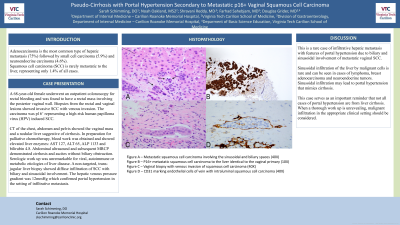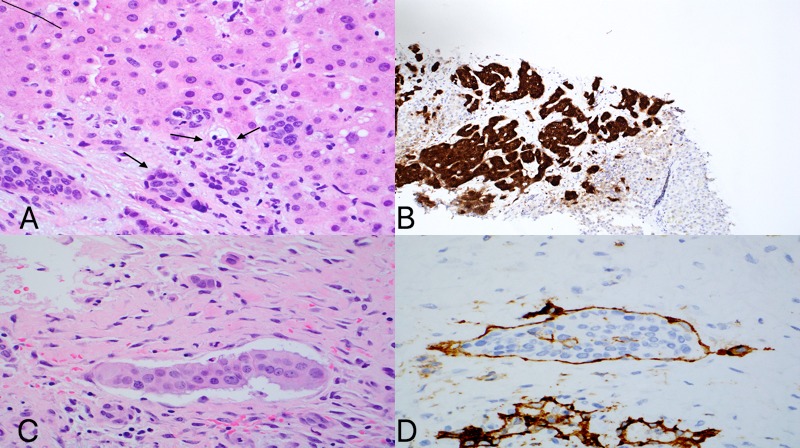Back


Poster Session D - Tuesday Morning
Category: Liver
D0579 - Pseudo-Cirrhosis With Portal Hypertension Secondary to Metastatic p16+ Vaginal Squamous Cell Carcinoma
Tuesday, October 25, 2022
10:00 AM – 12:00 PM ET
Location: Crown Ballroom

Has Audio

Sarah Schimming, DO
Virginia Tech Carilion School of Medicine
Roanoke, VA
Presenting Author(s)
Sarah Schimming, DO1, David N. Oakland, BS2, Shravani Reddy, MD1, Farhad Sahebjam, MD1, Douglas Grider, MD1
1Virginia Tech Carilion School of Medicine, Roanoke, VA; 2Virginia Tech Carilion, Roanoke, VA
Introduction: The liver is a common site of metastasis. Adenocarcinoma is the most common type of hepatic metastasis (75%) followed by small cell carcinoma (5.9%) and neuroendocrine carcinoma (4.6%). Squamous cell carcinoma (SCC) is rarely metastatic to the liver, representing only 1.4% of all cases. Presented is the first reported case of metastatic p16+ vaginal SCC to the liver with biliary and sinusoidal involvement clinically mimicking portal hypertension caused by cirrhosis.
Case Description/Methods: A 68-year-old female underwent an outpatient colonoscopy for rectal bleeding and was found to have a rectal mass involving the posterior vaginal wall. Biopsies from the rectal and vaginal lesions showed invasive SCC with venous invasion (Figures 1C & 1D). The carcinoma was p16+ representing a high-risk human papilloma virus induced SCC. Computed tomography of the chest, abdomen and pelvis showed the vaginal mass and a nodular liver suggestive of cirrhosis. In preparation for palliative chemotherapy, blood work was obtained and showed elevated liver enzymes: aspartate aminotransferase 127 U/L, alanine aminotransferase 65 U/L, alkaline phosphatase 1133 U/L and bilirubin 4.8 mg/dL. Concern for biliary obstruction prompted inpatient evaluation. Abdominal ultrasound and subsequent magnetic resonance cholangiopancreaticogram (MRCP) demonstrated cirrhosis and ascites without biliary obstruction. Serologic work up was unremarkable for viral, autoimmune or metabolic etiologies of liver disease. A non-targeted, trans-jugular liver biopsy showed diffuse infiltration of SCC with biliary and sinusoidal involvement (Figure 1A & 1B). The hepatic venous pressure gradient was 12mmHg which confirmed portal hypertension in the setting of infiltrative metastasis. Given the extent of disease, the patient opted for palliative radiation with transition to hospice care.
Discussion: This is a rare case of infiltrative hepatic metastasis with biliary and sinusoidal involvement due to vaginal SCC. Sinusoidal infiltration of the liver by malignant cells is rare and can be seen in cases of lymphoma, breast adenocarcinoma and neuroendocrine tumors. Sinusoidal infiltration may lead to portal hypertension that mimics cirrhosis. This case serves as an important reminder that not all cases of portal hypertension are from liver cirrhosis. When a thorough work up is unrevealing, malignant infiltration in the appropriate clinical setting should be considered.

Disclosures:
Sarah Schimming, DO1, David N. Oakland, BS2, Shravani Reddy, MD1, Farhad Sahebjam, MD1, Douglas Grider, MD1. D0579 - Pseudo-Cirrhosis With Portal Hypertension Secondary to Metastatic p16+ Vaginal Squamous Cell Carcinoma, ACG 2022 Annual Scientific Meeting Abstracts. Charlotte, NC: American College of Gastroenterology.
1Virginia Tech Carilion School of Medicine, Roanoke, VA; 2Virginia Tech Carilion, Roanoke, VA
Introduction: The liver is a common site of metastasis. Adenocarcinoma is the most common type of hepatic metastasis (75%) followed by small cell carcinoma (5.9%) and neuroendocrine carcinoma (4.6%). Squamous cell carcinoma (SCC) is rarely metastatic to the liver, representing only 1.4% of all cases. Presented is the first reported case of metastatic p16+ vaginal SCC to the liver with biliary and sinusoidal involvement clinically mimicking portal hypertension caused by cirrhosis.
Case Description/Methods: A 68-year-old female underwent an outpatient colonoscopy for rectal bleeding and was found to have a rectal mass involving the posterior vaginal wall. Biopsies from the rectal and vaginal lesions showed invasive SCC with venous invasion (Figures 1C & 1D). The carcinoma was p16+ representing a high-risk human papilloma virus induced SCC. Computed tomography of the chest, abdomen and pelvis showed the vaginal mass and a nodular liver suggestive of cirrhosis. In preparation for palliative chemotherapy, blood work was obtained and showed elevated liver enzymes: aspartate aminotransferase 127 U/L, alanine aminotransferase 65 U/L, alkaline phosphatase 1133 U/L and bilirubin 4.8 mg/dL. Concern for biliary obstruction prompted inpatient evaluation. Abdominal ultrasound and subsequent magnetic resonance cholangiopancreaticogram (MRCP) demonstrated cirrhosis and ascites without biliary obstruction. Serologic work up was unremarkable for viral, autoimmune or metabolic etiologies of liver disease. A non-targeted, trans-jugular liver biopsy showed diffuse infiltration of SCC with biliary and sinusoidal involvement (Figure 1A & 1B). The hepatic venous pressure gradient was 12mmHg which confirmed portal hypertension in the setting of infiltrative metastasis. Given the extent of disease, the patient opted for palliative radiation with transition to hospice care.
Discussion: This is a rare case of infiltrative hepatic metastasis with biliary and sinusoidal involvement due to vaginal SCC. Sinusoidal infiltration of the liver by malignant cells is rare and can be seen in cases of lymphoma, breast adenocarcinoma and neuroendocrine tumors. Sinusoidal infiltration may lead to portal hypertension that mimics cirrhosis. This case serves as an important reminder that not all cases of portal hypertension are from liver cirrhosis. When a thorough work up is unrevealing, malignant infiltration in the appropriate clinical setting should be considered.

Figure: Figure 1A - Metastatic squamous cell carcinoma involving the sinusoidal and biliary spaces (note arrows) (40X)
Figure 1B - P16 positive metastatic squamous cell carcinoma to the liver identical to the vaginal primary (10X)
Figure 1C - Vaginal biopsy with venous invasion of squamous cell carcinoma (H&E 40X)
Figure 1D - CD31 marking endothelial cells of vein with intraluminal vaginal squamous cell carcinoma (40X)
Figure 1B - P16 positive metastatic squamous cell carcinoma to the liver identical to the vaginal primary (10X)
Figure 1C - Vaginal biopsy with venous invasion of squamous cell carcinoma (H&E 40X)
Figure 1D - CD31 marking endothelial cells of vein with intraluminal vaginal squamous cell carcinoma (40X)
Disclosures:
Sarah Schimming indicated no relevant financial relationships.
David Oakland indicated no relevant financial relationships.
Shravani Reddy indicated no relevant financial relationships.
Farhad Sahebjam indicated no relevant financial relationships.
Douglas Grider indicated no relevant financial relationships.
Sarah Schimming, DO1, David N. Oakland, BS2, Shravani Reddy, MD1, Farhad Sahebjam, MD1, Douglas Grider, MD1. D0579 - Pseudo-Cirrhosis With Portal Hypertension Secondary to Metastatic p16+ Vaginal Squamous Cell Carcinoma, ACG 2022 Annual Scientific Meeting Abstracts. Charlotte, NC: American College of Gastroenterology.
